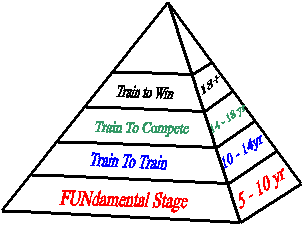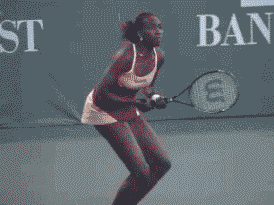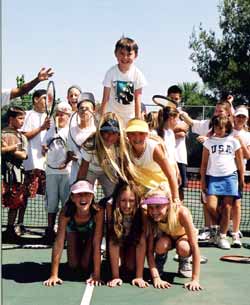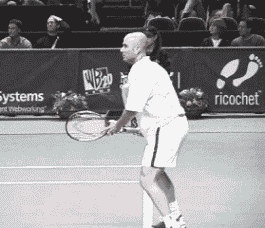<% ns_puts [mkm_getnavbar] %>

Long-Term Athlete Development
Peter D. McCraw
IMG Academies – Bollettieri Tennis Academy
What does it take to create a junior or a professional champion? The answer is complex, but one factor that has been generally overlooked in tennis coaching is what we call long-term athletic development. To maximize a player’s potential, coaching methodology should be based on a long-term philosophy. This philosophy takes into account the development of the athlete over time, not just short term competitive results. Long-term development is the basis for training in Olympic sports. Unfortunately, as in so many areas of coaching, tennis is lagging far behind when it comes to recognizing or implementing this critical principle.
|
The Ten-year or 10,000 Hour Rule
Scientific
research has concluded that it takes eight to twelve years of training for
an athlete to reach elite levels. This is called the ten-year or 10,000
hour rule. For the athlete, coach, and parents, this translates into
slightly more than three hours of deliberate practice a day, for a period
of ten years.
Unfortunately,
too many coaches still approach training with an attitude best
characterized as “win by Friday”. Too often, the long-term interests
of a player is sacrificed for short-term tournament results and
rankings. Typically, coaches with this attitude develop players who
are over-coached but under-developed. Many successful players trained with
this approach reach the 16s or 18s age divisions without a clearly defined
style of play, or with significant technical, tactical, mental, or
physical limitations. At this point it’s too late to reverse the damage.
The players’ potential growth has been stunted.
A specific and well-planned training regime ensures optimum development throughout an athlete’s career. This means developing every aspect of the game and helping a player meld his skills into a personal playing style. A long term development plan also gives coaches the ability to control another critical factor in training: the stress-recovery cycle. If the stress-recovery cycle is not properly understood and addressed it can lead to overtraining, burn out, and major injuries. Ultimately success comes from training and performing well over the long-term rather than winning in the short-term.
|
Training Requirements of
Different Sports
In principle, sports can be classified as either early specialization or late specialization sports. Early specialization sports include gymnastics, figure skating, diving, and swimming. These sports require early recruitment of athletes and early specialized training. Late specialization sports include golf, racquet sports, all ball games, cycling, and combative sports. These require the opposite approach. Here a generalized approach to early training is key. The early emphasis should be on the development of general, fundamental motor skills.
Because tennis is a late specialization sport, we do not recommend coaches, parents, and children adopt an early specialization regime prior to the age of ten. The ages of 9 to 12, often called ‘Golden Age,’ are one of the most important periods of motor development for children. It is during this period that children are developmentally ready to acquire the fundamental movement skills that are the cornerstones of all athletic development.
|
These fundamental skills include running, hopping, bounding, throwing, and jumping. The introduction of the ABC’s of athleticism (agility, balance, coordination, speed) during this period lay the foundation for later years. The basic fundamental skills must be practiced and mastered before higher level sport specific skills can be successfully learned, hence, at a young age we encourage participation in a wide variety of sports.
The emphasis on motor skill development in a positive, supportive, and fun environment will yield athletes who have a better trainability for long-term tennis specific development. Research indicates that if fundamental motor skill training is not developed between the ages of 9-12, the loss of motor skill development cannot be recaptured at a later time.
To compensate for possible early shortcomings of athlete preparation, we place significant emphasis on planning, periodization, pediatric exercise physiology, growth & maturation, motor learning, and sport psychology in the later stages of development (see below).
The 4
Stage Model of Long-Term Athlete Development
 Because
tennis is a late specialization sport, we adopt a four stage training
model which consists of:
Because
tennis is a late specialization sport, we adopt a four stage training
model which consists of:
1 - FUNdamental stage
2 - Training to Train stage
3 - Training To Compete stage
4 - Training to Win stage
Stage 1
– FUNdamental StageTM
- Age 5
to 10 years.
.jpg)
.jpg)
The FUNdamental stage is well structured and fun! The emphasis is on the overall development of an athletes physical capacities, and fundamental movement skills (The ABC’s - Agility, Balance, Coordination and Speed).
Participation in as many sports as possible is encouraged. Speed, power, and endurance are developed using FUN games. Correct running, jumping, and throwing techniques are taught.
The use of ‘own body weight’ games, medicine ball and Swiss ball exercises are encouraged and athletes are introduced to the simple rules and ethics of sports. No Periodization takes place, but all programs are structured and monitored.
.jpg) Stage
2 – Training To Train StageTM
Stage
2 – Training To Train StageTM
Age
· Male: 10 to 14
· Female: 10 to 13
During the Training to Train stage, young athletes learn how to train and learn the basic tennis skills as well as technical/tactical skills, and ancillary capacities such as: warming up and cooling down, stretching, hydration and nutrition, recovery and regeneration, relaxation and focusing, taper and peaking for competition.
During competition athletes’ play to win and to do their best, however, the focus of training is on learning the basics as opposed to competing at this stage. Training and competition ratios are optimized because too many competitions will waste valuable training time. Conversely, not enough competition will inhibit the practice of technical skills and the ability to face the physical and mental challenges presented during competition.
A 75% training to 25% competition ratio is recommended by experts during the Training to Train stage, however, these percentages will vary according to a players individual needs.
|
The underlying attitude of the coach, parent and player during this stage is to focus on the process (training and performing to one’s actual best capacity) rather than the outcome (winning). We believe that athletes undertaking this type of preparation are better prepared for competition in both the short and long-term, than athletes who focus solely on the rankings and tournament wins during these years.
It is important to note that the 25% competition ratio refers to actual tournament play. Players in this stage still compete daily, in the form of practice matches and competitive games and drills. We adopt a single periodized framework with one major competition for every 10 to 23 weeks of development. By the age of 13-14, two distinctive competitive seasons are planned and implemented.
The Training to Train stage addresses the critical period of physical and skill development. If an athlete misses this stage of training, they may never reach their full potential. The reason we see so many athletes plateau during the later stage of their careers is primarily due to an over emphasis on competition instead of training during this critical period in their athletic development.
Stage 3
– Training To Compete StageTM
.jpg) Age
Age
· Male: 14 to 18
· Female: 13 to 17
During the Training to Compete stage, high intensity, tennis specific training is provided to athletes year round. Athletes learn how to perform all of the learned skills under a variety of competitive conditions and are exposed to all possible competitive conditions during training. Special emphasis is placed on optimum preparation by modeling training and competition.
Fitness
programs, recovery programs, psychological preparation and technical
development are individually tailored to a greater degree. These
activities are organized above and beyond group preparation to address
each player’s individual weaknesses. This phase of development is
introduced after the goals and objectives of the Training to Train stage
have been achieved. The training to competition ratio now changes to
50:50. However, this will vary according to sport and individual
specific needs. During this phase, we adopt a double periodized
framework with 2 competitive seasons for every 14-16 weeks of development.
For ages 17-18, a triple periodization framework allows players to
compete at the highest level and still address their developmental needs.
.jpg) Stage
4 – Training To Win StageTM
Stage
4 – Training To Win StageTM
Age
· Male: 18+
· Female: 17+
This is the final stage of athletic preparation. All of the athletes physical, technical, tactical, mental, and ancillary capacities are now fully established with the focus of training shifting to the optimization of performance. Athletes are trained to peak for major competitions. Training to competition ratio in this stage is 25:75, with the 75% competition ratio including competition specific training activities. A multiple periodized framework (3 or more competitive seasons) is adopted for an athlete’s playing calendar.
When it is all said and done, there are no short cuts to long-term athlete development. Optimizing the technical, tactical, mental and physical development of our athletes is the best investment we can make in their future as tennis players and as outstanding citizens in the community long after they leave our care.
Your comments are welcome. Let us know what you think about this article by emailing us here at TennisONE.
Peter D. McCraw
High
Performance Development Coach
IMG Academies – Bollettieri Tennis Academy
He is a member of the USPTA and a Specialist in
Competitive Player Development.
He holds a Post Graduate Degree in Human Movement
from Deakin University – Australia.
Last Updated 7/15/01. To contact us, please email to: webmaster@tennisone.com
TennisONE is a registered trademark of TennisONE and SportsWeb ONE; Copyright 1995. All rights reserved.




